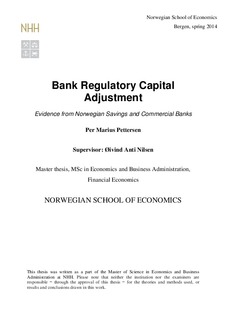Bank regulatory capital adjustment : evidence from Norwegian savings and commercial banks
Master thesis
Permanent lenke
http://hdl.handle.net/11250/224002Utgivelsesdato
2014Metadata
Vis full innførselSamlinger
- Master Thesis [4372]
Sammendrag
A growing body of theoretical literature suggests that banks have a target capital structure.1
This idea is supported by the empirical findings that it exists a large cross sectional variation
in regulatory capital ratios and that these ratios often are well above the minimum
requirements. Rationalized by a simple cost-benefit analysis, the literature suggests that
profit-maximising banks choose a target capital ratio to which they actively adjust over some
time period.
This master thesis examines the regulatory capital adjustments of Norwegian banks over the
period 1993q1 to 2013q1. Firstly, we analyse the factors contributing to banks’ unobservable
target capital ratios and the speed at which banks adjust their capital structure. Secondly, we
investigate how these adjustments are performed.
We find evidence for capital optimization in terms of the Tier 1 capital ratio. A notable
finding is that Norwegian banks face substantial costs of adjusting their capital ratios. On
average, Norwegian banks close only 4.1 percent of the gap between their effective capital
ratio and target each quarter. Cost of adjusting capital may therefore be an important
explanation why they hold capital ratios above the regulatory minimum. Banks’ target capital
ratio is shown to decrease with bank size. On the other hand, an increase in earnings capacity
and managers’ perception of risk is shown to increase target capital ratios.
Adjustments towards target capital ratios have significant impact on both assets and capital.
Our result indicates that Norwegian banks prefer to fine-tune their risk-weighted assets
instead of making real changes to the size of their balance sheet when being away from their
target capital ratio. Furthermore, we find that banks are more likely to increase their capital
levels when they are below their target capital ratios, than they are to decrease it when they
are above.
